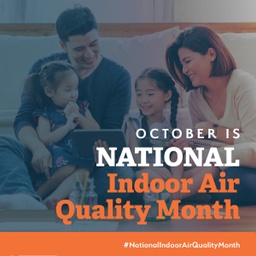October is national indoor air quality month
Indoor Air Quality (IAQ): the air quality within and around buildings and structures, especially as it relates to the health and comfort of building occupants.
October is National Indoor Air Quality Month and a great opportunity to learn about healthy indoor air (or share your awareness of the issue with others!)
According to the EPA, research shows that people spend approximately 90% of their time indoors. With so many of us spending more time than ever at home due to the pandemic, "indoor air quality" has become quite the popular phrase—but what does it really mean? What constitutes good indoor air quality?
The Indoor Air Quality Association states that allergens, viruses, bacteria, and gasses can all travel through the air and make us sick. To know if you and your family are at risk, it's essential to monitor for indoor air pollutants and take action if they are present in dangerous levels in your home, office or school.
When choosing an indoor air monitor, it can be helpful to know what is being measured, and why. Here are substances to pay attention to, what they are and why it's important to monitor for them.
What is Radon?
Radon is a naturally occurring, radioactive gas that you cannot see or smell. Radon is normally found at very low levels outdoors but can accumulate in the air in homes and other buildings. Breathing in elevated levels of Radon over long periods can lead to health issues, including lung cancer. In fact, Radon is the leading cause of lung cancer among non-smokers, according to the EPA.
Why is it important to monitor for Radon, and over the long term?Radon levels fluctuate based on your home’s ventilation, airflow, weather conditions, and seasons. Furthermore, changes or deterioration of the foundation, windows, isolation, and vapor barriers, to name a few, can impact Radon levels. Therefore, long-term, continuous Radon level monitoring will provide the peace of mind even post Radon inspection and mitigation.
What are Total Volatile Organic Compounds (tVOCs)?
A Volatile Organic Compound (VOC) is defined as any compound containing carbon that can be readily vaporized, except methane. VOCs, measured in totality of its mixed gases or tVOC, are released into indoor environments from cleaning and disinfecting products, paints, wood preservatives, carpeting, building materials, aerosols, insect repellents, microbial growth, and a host of other sources.
Why is it important to monitor for tVOCs?
At elevated levels, Volatile VOCs can cause eye, nose, and throat irritation; headaches, loss of coordination, nausea; damage to liver, kidney, and central nervous system. Some organics (such as Benzene) are suspected or known to cause cancer. Key signs or symptoms associated with exposure to elevated levels of VOC's include eye infections and irritation, nose and throat discomfort, headache, allergic skin reaction, shortness of breath, signs of poisoning, nausea, vomiting, nose bleeding, fatigue, and dizziness.
What are Carbon Dioxide Equivalents (eCO2) and why is it helpful to monitor for them? Carbon dioxide (CO2) equivalents, or eCO2 for short, are derived from the measurements of the mixed gases, tVOCs, and describe the quality of indoor air in equivalent units of CO2. Traditionally indoor air quality is limited to the measurement of temperature, humidity, and carbon dioxide alone. eCO2, however, follows increasing CO2 levels but also contains information about additional harmful mixed gases and odorous events, while a CO2 sensor detects just the exhaled CO2 from the room’s occupants.
 To learn more about indoor air quality, visit these resources:
To learn more about indoor air quality, visit these resources:
Or simply search #NationalIndoorAirQualityMonth
Have a great October and #BreatheHealthy!
Concerned about the air quality in your home, office or school? Click Here to learn more about lüft® Plug-in Indoor Air Quality and Radon Monitor.


